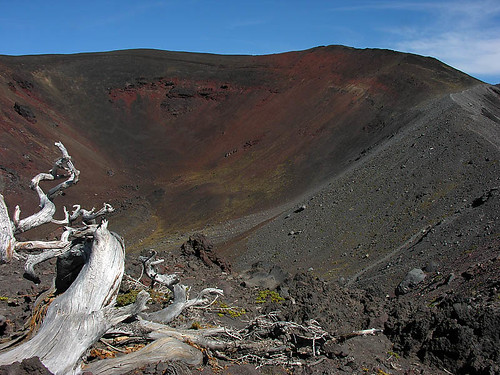I finally remembered to bring my GSA notes with me to the office, so I can finally post a wrap up of what I saw/heard at the big 2009 meeting in Portland. I'll have a specific post on Kasatochi - too much to say here. However, a great time was had by all!

The crater of Collier Cone in Oregon. The scoria cone likely experienced years of explosive strombolian eruptions when it formed.
Some interesting volcano-related notes:
- Clive Oppenheimer pointed out that the Toba eruption 74,000 years ago covered >1% of the Earth's surface with >10 cm (~4 in) ash. To put that in perspective, the Earth is ~196,940,400 square miles / 504,167,000 km2, so Toba blanketed almost 200,000 square miles / 500,000 km2 with more than 10 cm ash - and 10 cm is enough to cause significant havoc to plants, breathing and water.
- I was personally excited to hear that South Sister in Oregon has erupted a lot of rhyolite/rhyodacite over its history - including Rock Mesa and Devil's Hills. Judy Feirstein from the USGS said that these silicic magmas are common throughout the activity of the volcano, which peaked from 20,000-40,000 years ago.
- Also on the South Sister front, it appears that any uplift that was happening on the volcano has ended. The west slope of the volcano was noticed to be very slightly bulging back in 2001 - adding up to a grand total of ~4.6 x 107 m3 - or roughly 3-5 cm uplift. However, most geophysical models for the uplift suggest that there is no mass flux towards the surface, so the likelihood of any eruption from this event is very low.
- If you've ever been up on Mackenzie Pass in the Central Oregon Cascades, you've seen a lot of the young (<3,000 year old) basaltic-to-basaltic andesite scoria cones that litter the landscape. Recent work by a group from the University of Oregon suggest that many of the scoria cones (Collier, Yapoah and 4-in-1 in specific) experienced explosive eruptions - specifically strombolian eruptions. They determined this by looking at the tephra deposits near the vents and compared them to the record at Paricutin in Mexico. These Oregon scoria cones likely experienced years of explosive eruptions if the deposits are any indication.
- Finally, did you know that kimberlites litter the eastern U.S.? There are kimberlites in middle New York, western Pennsylvania, North Carolina and more. Likely they are caused by reactivation of structural features related to the various orogenies that east coast has experienced, but I had no idea.
- Log in to post comments
More like this
News!
Toba caldera in Indonesia.
We're all still talking about the Chilean earthquake and the coverage of the event. If you happen to live in the Columbus area, you might have heard me on WTVN talking about the earthquake as well.
The Toba (Indonesia) eruption 74,000 years ago has been used by…
Back in the days when Eruptions was on Wordpress, I held a vote about what volcano should be the next to be profiled on this blog. The winner was Mt. Hood in Oregon, and after much waiting, the profile is here. I will actually be out of town until Monday doing some house shopping in this little…
Sally Sennert from the Smithsonian Institution sent me an email to say that this week's USGS/Smithsonian Institute Weekly Volcanic Report will be delayed due to the inclement weather in the Washington DC area. She can't connect with the server, so the report can't be updated on the Smithsonian…
I will be away from Eruptions for the next 2 weeks or so. I won't be on vacation, I will actually be out on volcanoes themselves doing some much-needed fieldwork. It is a three volcano tour, starting with a trip to Lassen Peak to get a guided view with Michael Clynne of the USGS (the world expert…

I just heard about the kimberlites (from a friend who has started working on them), too! Weird. Or not, maybe, from the conversation we had in the beer line.
Kimberlites in NY? Damn it, and I just left there too.
You dont suppose theres a sweet little old kimberlite pipe hiding under a morraine up there somewhere, do ya?
Kimberlites? Guess there are no diamonds, or some would have been found by now.
By the way: the GVP site is up and running again :o)
Kimberlites in young rocks are generally barren because the hotter geotherm (compared to the Archean rocks) means that the graphite / diamond transition depth is pushed down below the source region.
This is why nobody looks for them in young rocks, which is why they have been overlooded for so long.
And before you ask, the Arkansas deposit is a lamproite, so has a deeper source.
my back-of-the-envelope math is coming up with a minimum of 5*10^10 cubic meters of material ejected from Toba. my mind is officially boggled; has anyone tried estimating by how much the area surrounding the vent might have sunk after losing so much material from underneath it?
Could we have more details on the kimberlites? such as where and when? Very fascinating and quite exciting! (diamonds, aside). How would or could such deep events have occurred?
Dr. Erik, The comment by Clive Oppenheimer pointing out that the Toba eruption 74,000 years ago covered >1% of the Earth's surface with >10 cm (~4 in) ash.
Dies that 1% include the water area or just the land area?
There is an interesting article about Mt.Toba, which presents evidence of a human population bottleneck occurring after the event 74K years ago.
http://www.andaman.org/BOOK/originals/Weber-Toba/textr.htm
It's a link from http://en.wikipedia.org/wiki/Toba_catastrophe_theory